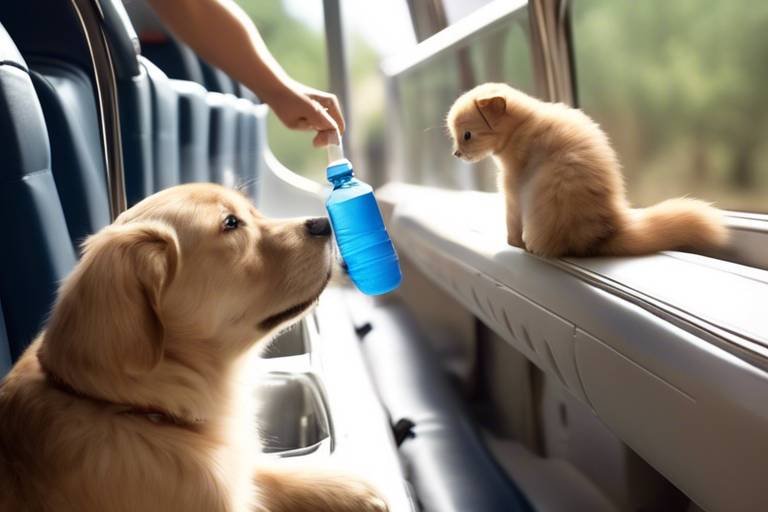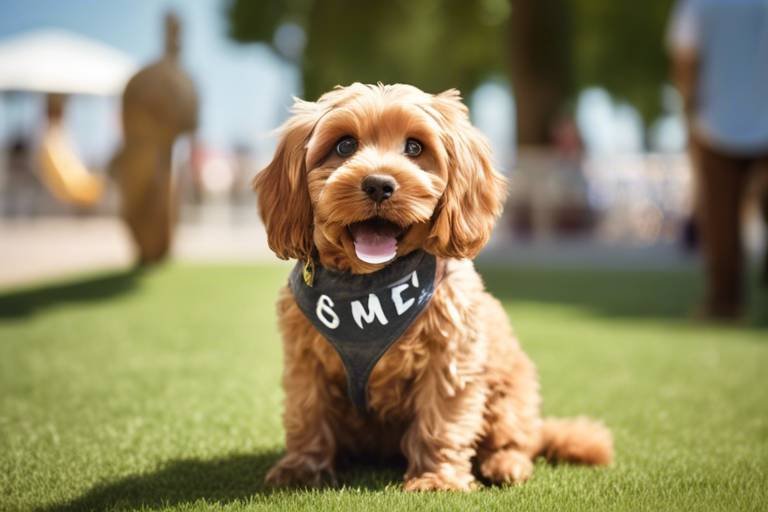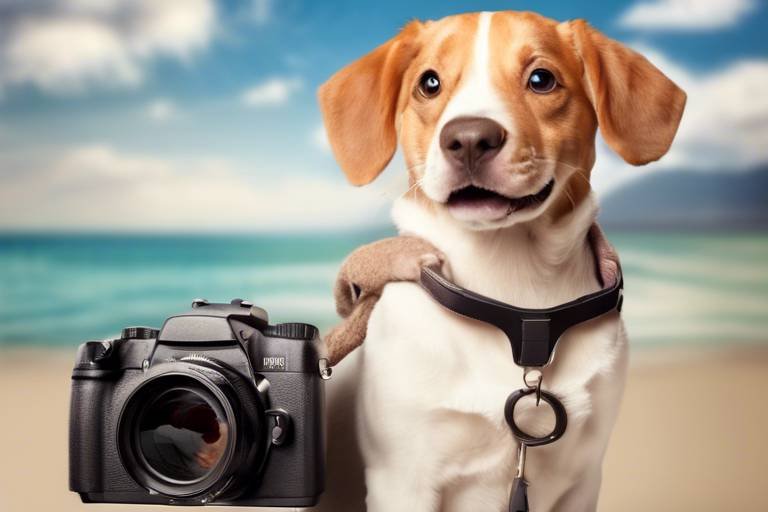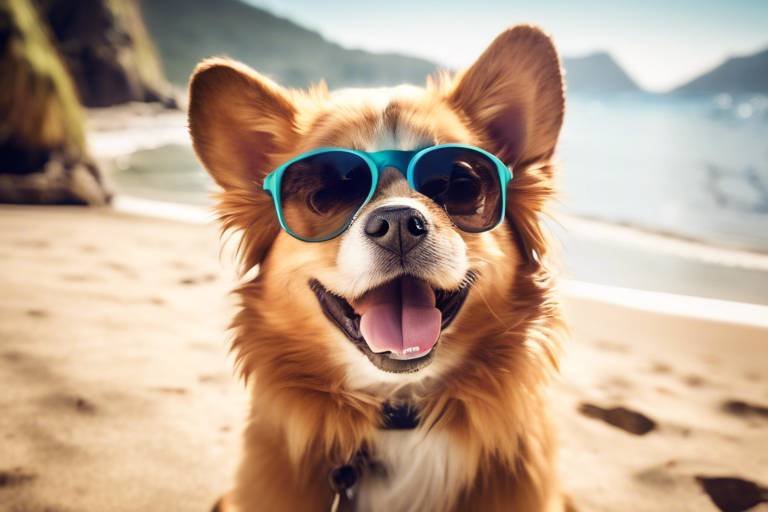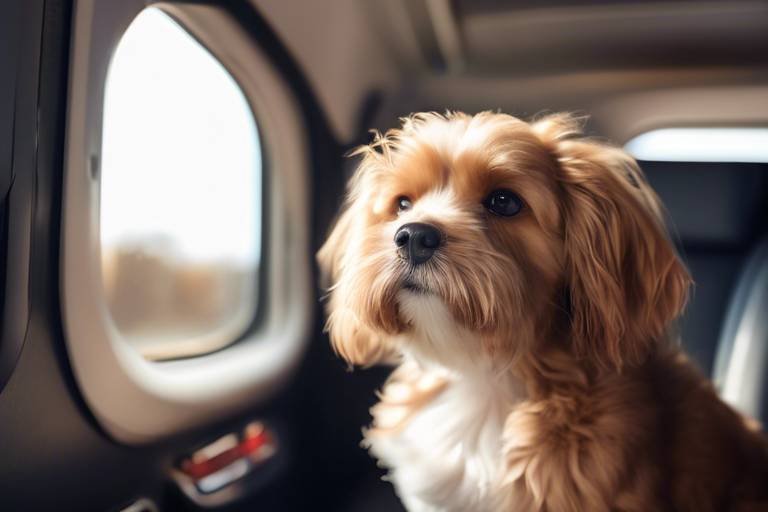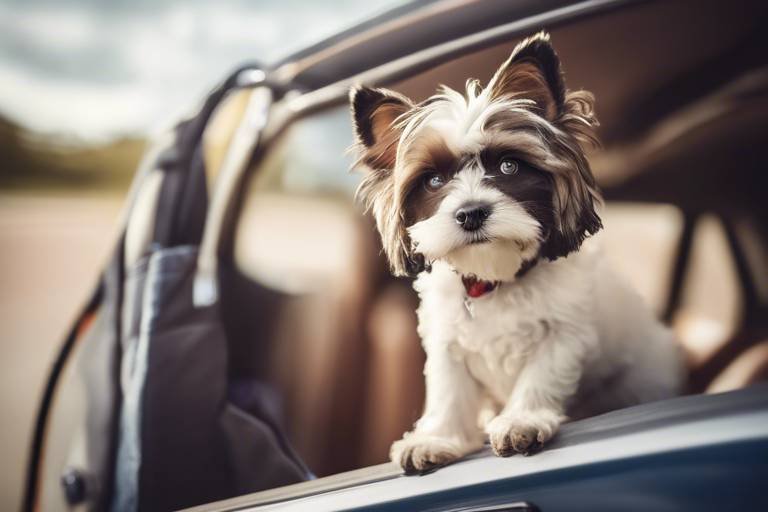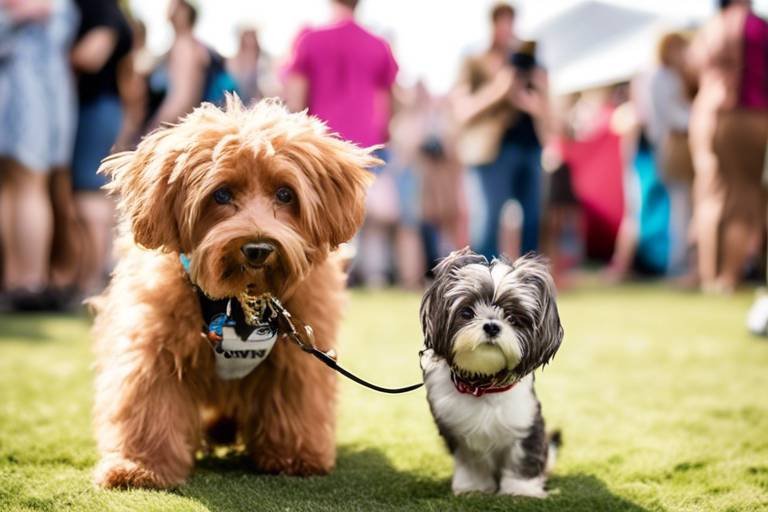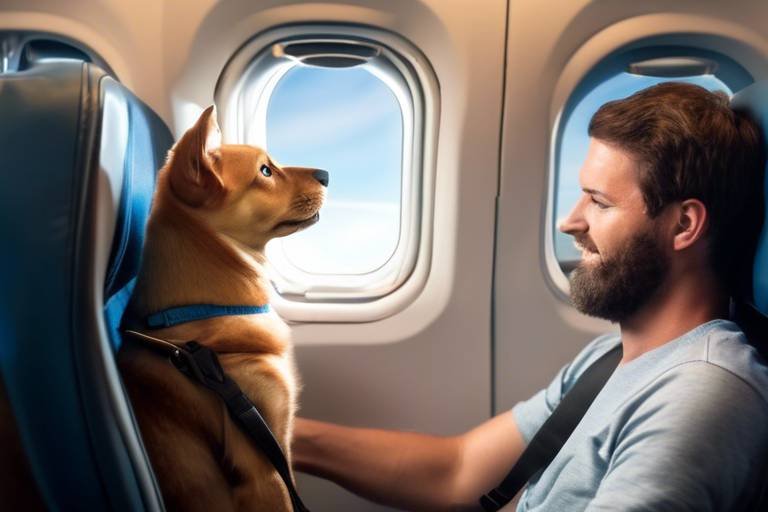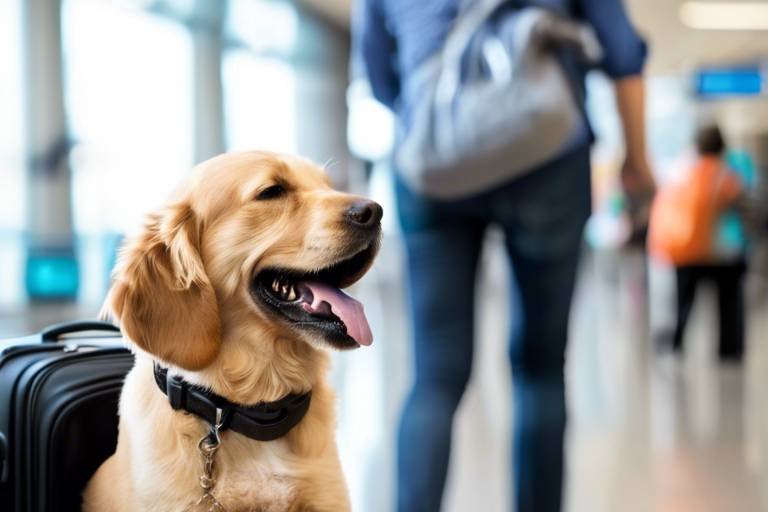Traveling with Pets - The Importance of Hydration
Traveling with your furry friends can be one of the most rewarding experiences, but it also comes with its own set of challenges. One of the most crucial aspects to consider is hydration. Just like humans, pets need a steady supply of water to stay healthy, especially when they're on the move. Imagine embarking on a long road trip or a camping adventure without access to fresh water—it sounds uncomfortable, right? Well, the same goes for your pets. Dehydration can lead to serious health issues, making it vital to keep your pets well-hydrated during your travels.
But how do you ensure your pet gets enough water on the go? It's all about planning and understanding their needs. Different animals have different hydration requirements. For instance, a small dog might need less water than a large breed, but both can suffer if they don't have access to water regularly. Knowing your pet's specific needs is the first step in keeping them hydrated.
In this article, we'll dive deep into the importance of hydration for pets while traveling. We'll explore effective strategies to keep your pets refreshed, discuss the best water containers to use, and identify the signs of dehydration to watch for. So, buckle up and get ready to make your next adventure with your pet a safe and enjoyable one!
When it comes to pet hydration, it's essential to grasp the basic principles. On average, pets need about 1 ounce of water per pound of body weight daily. However, this can vary based on factors like activity level, climate, and diet. For example, if your pet is active or the weather is particularly hot, their water requirements may increase significantly.
As a responsible pet owner, you should be on the lookout for signs of dehydration. These can include dry gums, excessive panting, and lethargy. If you notice any of these symptoms, it's crucial to act quickly. Dehydration can escalate rapidly, leading to more severe health issues if left unaddressed.
Selecting an appropriate water container is essential for easy access to hydration while traveling. Whether you're hitting the road or flying to a new destination, having the right tools can make all the difference. From portable water bowls to insulated bottles, there are various options available that cater to different pet sizes and travel conditions.
Portable water bowls are a game-changer for pet owners on the go. Lightweight and easy to carry, they make it simple to provide hydration during road trips or hikes. Imagine being out on a trail and your furry friend looks up at you with those big, thirsty eyes. Having a portable water bowl ready can turn a potentially stressful situation into a refreshing moment.
Collapsible bowls are particularly handy as they save space in your travel gear. They can be easily tucked away in a backpack or even a pocket when not in use. Just pop it open, fill it with water, and let your pet hydrate. It's like having a water fountain that fits in your pocket!
On hot days, insulated water bottles can keep your pet's water cool for longer periods. This means refreshing hydration is always just a sip away, no matter how long your journey. Think of it as a mini cooler for your pet—ensuring they stay cool and comfortable even when the temperature rises.
Implementing effective hydration strategies can significantly impact your pet's well-being during travel. Schedule regular water breaks, especially on long journeys. Just like you wouldn't skip bathroom breaks on a road trip, your pet shouldn't go too long without water. Consider setting reminders or planning stops where you can let your pet drink and stretch their legs.
Being able to identify the signs of dehydration in pets is vital for their safety. Understanding the key symptoms can help you respond quickly to your pet's needs and ensure they remain healthy throughout your travels.
Physical symptoms of dehydration can be subtle at first but can escalate quickly. Look out for dry gums, lethargy, and loss of skin elasticity. To check skin elasticity, gently pinch the skin on the back of your pet's neck. If it doesn't bounce back quickly, it might be a sign that your pet is dehydrated.
Behavioral changes can also indicate dehydration. If your pet is panting excessively or seems reluctant to move, it could be a sign that they need a drink. Just like humans, pets can become irritable when they're thirsty. So, keep an eye out for these changes in behavior, as they can be crucial indicators of your pet's hydration status.
Different travel scenarios require tailored hydration strategies. For instance, during road trips, make frequent stops to allow your pet to drink. On flights, ensure you have a spill-proof water container that meets airline regulations. If you're camping, plan your water supply ahead of time to ensure your pet has access to fresh water throughout your adventure.
- How often should I give my pet water while traveling? – It's best to offer water every couple of hours, especially during long trips.
- Can I use bottled water for my pet? – Yes, bottled water is usually safe for pets, but always check the label for any added minerals.
- What should I do if my pet refuses to drink water? – Try offering ice cubes or flavored water to entice them, and consult your vet if the issue persists.
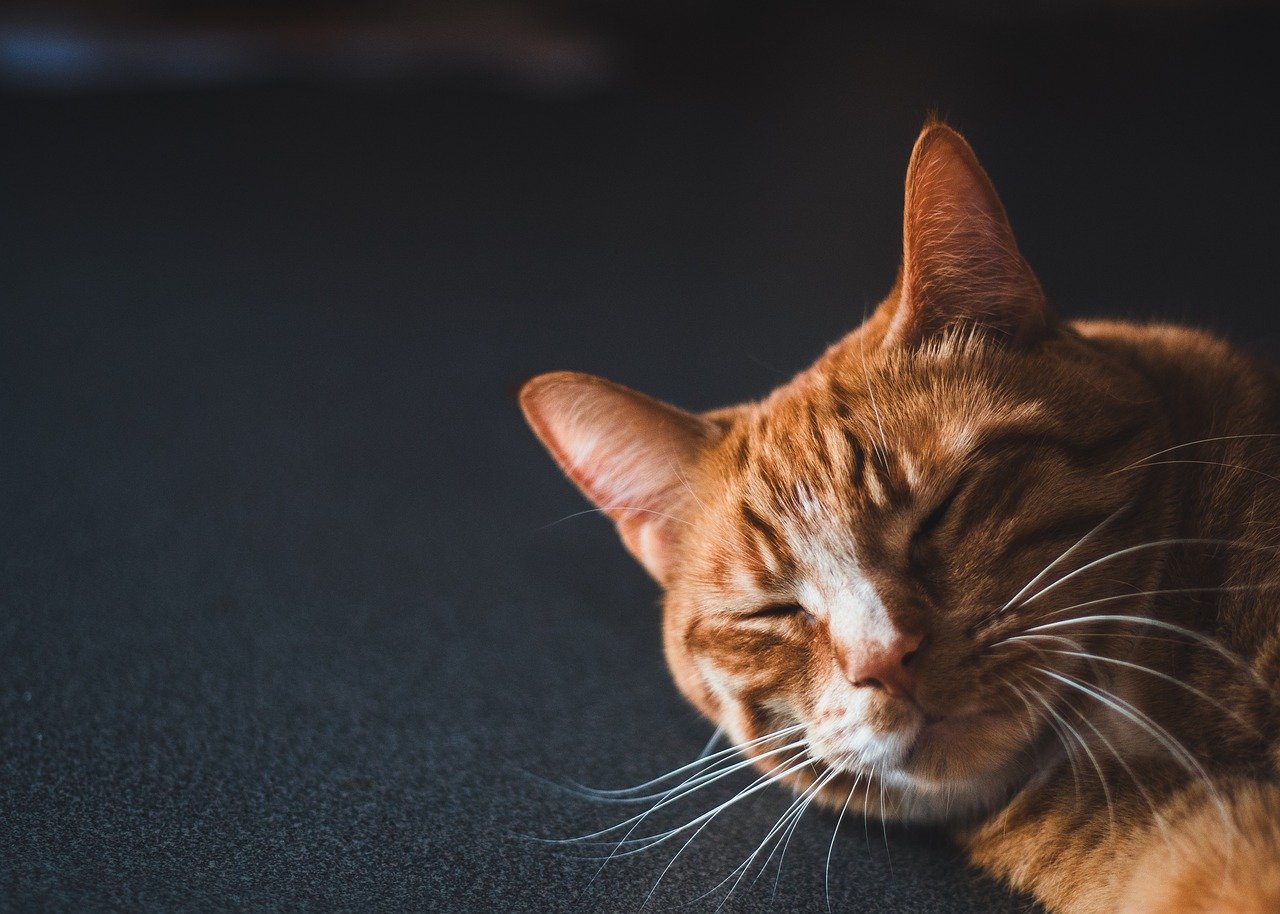
Understanding Pet Hydration
When it comes to our furry companions, hydration is not just important; it's absolutely crucial for their health and well-being. Just like us, pets need a consistent supply of water to thrive. But how much water do they actually need? Generally, the amount can vary based on several factors, including the pet's size, age, activity level, and even the climate. For instance, a small dog might require around 1 ounce of water per pound of body weight daily, while a larger breed may need significantly more. This is why it's vital to keep an eye on their water intake, especially when you're on the go.
As you embark on your travels, it's essential to recognize the signs of dehydration. Pets may not always show obvious signs that they need water, so being vigilant is key. Look out for physical symptoms such as dry gums, lethargy, and loss of skin elasticity. These indicators can be subtle, but they are often the first alarms signaling that your pet may be dehydrated. If you pinch the skin on the back of their neck and it doesn't spring back quickly, that's a clear sign they need a drink!
But physical symptoms are just one part of the equation. Behavioral changes can also be significant indicators of dehydration. For example, if your pet is panting excessively or seems reluctant to move, it might be time to offer them some water. Animals are often better at hiding their discomfort than we realize, so being proactive can make all the difference. Remember, a hydrated pet is a happy pet!
To help you understand hydration needs better, here's a quick reference table that outlines the average daily water requirements for different pets:
| Pet Type | Average Daily Water Requirement |
|---|---|
| Small Dog (up to 20 lbs) | 1/2 to 1 ounce per pound |
| Medium Dog (20-60 lbs) | 1 to 1.5 ounces per pound |
| Large Dog (over 60 lbs) | 1 to 2 ounces per pound |
| Cat | 1 ounce per pound |
In summary, understanding your pet's hydration needs is a vital part of responsible pet ownership, especially when traveling. By being aware of how much water they need and recognizing the signs of dehydration, you can ensure your furry friend stays healthy and happy on your adventures together. Remember, keeping a close eye on their hydration not only helps them feel their best but also allows you to enjoy your travels without any worries!
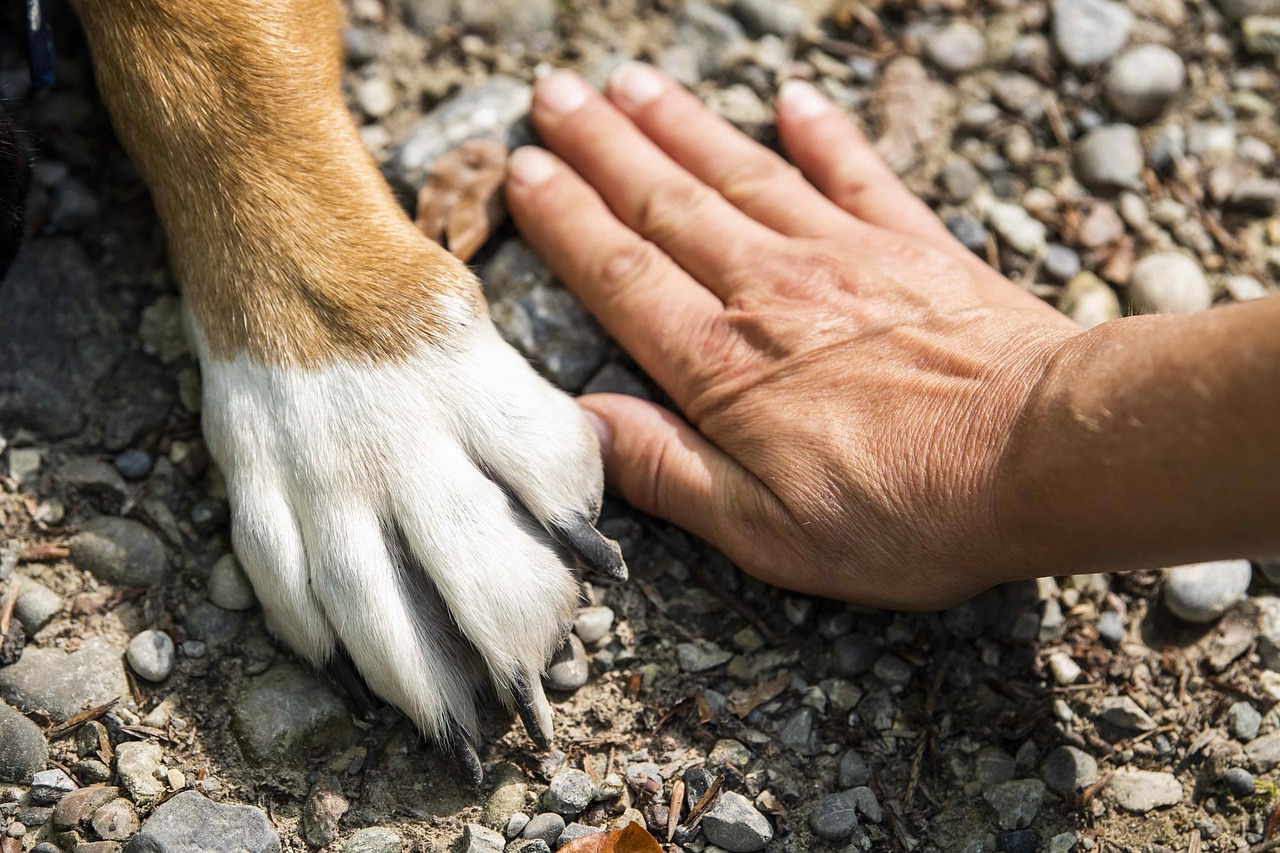
Choosing the Right Water Container
When traveling with your furry friend, one of the most crucial aspects to consider is how you'll keep them hydrated. Just like us, pets need a consistent supply of water to stay healthy and happy, especially when they're in new environments. The right water container can make all the difference in ensuring your pet has easy access to hydration during your adventures. You wouldn't want to be stuck in a hot car with no water, right? Similarly, your pet shouldn't have to suffer from thirst while you're on the go.
There are various options available, each catering to different needs and travel conditions. It's essential to choose a container that suits both your pet's size and your travel style. For instance, larger breeds may require bigger bowls, while smaller pets might do just fine with something compact. Let’s dive into some popular choices:
Portable water bowls are a fantastic solution for pet owners on the move. These bowls are lightweight, easy to carry, and can be used anywhere—whether you’re on a road trip, hiking, or just taking a stroll in the park. Imagine being able to whip out a bowl and give your pet a refreshing drink without any hassle! It's like having a personal hydration station right at your fingertips.
If space is a concern, collapsible bowls are a game-changer. They can easily fold down to fit into your bag or pocket, making them incredibly convenient for travel. Just think of them as the Swiss Army knife of pet hydration! You can set them up in seconds and pack them away just as quickly. Plus, they come in various materials, including silicone and fabric, which are durable and easy to clean.
Now, let’s talk about insulated water bottles. These are perfect for keeping water cool, especially during those hot summer days. Imagine hiking under the blazing sun and having a chilled drink ready for your pet when you take a break. It’s like offering them a refreshing oasis in the middle of a desert! Insulated bottles often come with built-in bowls or spouts, making it easy to pour water for your pet without any spills.
In addition to these options, consider the following points when choosing the right water container:
- Material: Look for BPA-free materials that are safe for your pet.
- Size: Ensure the container is appropriate for your pet’s breed and size.
- Ease of Cleaning: Choose containers that can be easily washed to maintain hygiene.
Ultimately, the right water container should reflect your pet’s needs and your travel habits. By investing in a quality hydration solution, you’ll not only keep your pet happy but also enhance the overall travel experience for both of you. Remember, a well-hydrated pet is a happy pet, and that’s what we all want during our adventures together!
Portable Water Bowls
When it comes to traveling with your furry friends, one of the best investments you can make is a portable water bowl. These handy accessories are not just a luxury; they are a necessity for keeping your pet hydrated on the go. Imagine your dog, panting after a long hike, or your cat, looking parched after a road trip—having a portable water bowl can be a lifesaver in such situations. They are designed to be lightweight and easy to carry, making them perfect companions for any adventure.
There are various types of portable water bowls available on the market today, each with its unique features. Here are a few reasons why these bowls are essential:
- Convenience: Portable water bowls can easily fit into your backpack or car, ensuring you always have access to water for your pet.
- Ease of Use: Most of these bowls can be set up in seconds, allowing you to provide hydration without hassle.
- Durability: Made from materials like silicone or stainless steel, portable bowls are designed to withstand the rigors of travel.
One of the standout features of portable water bowls is their collapsible design. These bowls can be flattened or folded, taking up minimal space in your gear. This is especially important when traveling with limited storage options, like in a backpack or a small car. Imagine having a bowl that can go from being flat as a pancake to a full-sized water bowl in just a matter of seconds! It's not just about saving space; it's about making your travel experience smoother.
Another great option is the insulated water bowl, which can keep water cool for longer periods. This is particularly beneficial during hot summer days when your pet might need a refreshing drink after a long walk. Keeping your pet hydrated is not just about having water available; it’s about ensuring that the water is appealing to them. Nobody wants to drink warm water, right? With insulated bowls, you can offer your pet a cool, refreshing drink, which they will appreciate immensely.
In summary, portable water bowls are a must-have for any pet owner who loves to travel. They provide a convenient and effective way to keep your pet hydrated, ensuring that your adventures are enjoyable for both you and your furry companion. So, before you hit the road or embark on a hike, make sure you pack a portable water bowl. It could make all the difference in your pet's comfort and health during your travels!
Q: How do I clean a portable water bowl?
A: Most portable water bowls are dishwasher safe or can be easily cleaned with soap and water. Always check the manufacturer's instructions for specific cleaning guidelines.
Q: Can I use a portable water bowl for food as well?
A: Yes, many portable water bowls can double as food bowls. Just ensure you clean them thoroughly before switching between water and food.
Q: Are there any specific materials I should look for?
A: Look for bowls made from durable, non-toxic materials like silicone or stainless steel. These are generally safe and easy to clean.
Collapsible Bowls
When it comes to traveling with your furry friends, are a game-changer. These nifty little inventions are designed with convenience in mind, allowing you to provide hydration to your pet without the bulk of traditional bowls. Imagine this: you're on a scenic road trip, the sun is shining, and your pup is panting from excitement. You pull over to a beautiful rest area, and instead of rummaging through your bags for a clunky water bowl, you simply unfold your collapsible bowl and fill it with fresh water. It’s that easy!
One of the main advantages of collapsible bowls is their space-saving design. Most of these bowls are made from lightweight materials that fold flat, making them perfect for pet owners who are conscious about packing efficiently. You can easily slip one into your backpack, purse, or even your pocket! Plus, they come in a variety of sizes, so whether you have a tiny Chihuahua or a big Golden Retriever, there’s a collapsible bowl that fits your needs.
Another benefit is their durability. Many collapsible bowls are made from silicone or other sturdy materials that can withstand the wear and tear of travel. They’re also typically dishwasher safe, which means cleaning them is a breeze. Just toss them in the dishwasher after a day of adventure, and they’re ready for your next outing!
Now, you might be wondering about the types of collapsible bowls available. Here’s a quick overview:
| Type | Features | Best For |
|---|---|---|
| Silicone Bowls | Flexible, lightweight, and often come with a carabiner clip. | Hiking and outdoor adventures. |
| Plastic Bowls | Sturdy and often cheaper; some have lids for easy transport. | Road trips and casual outings. |
| Foldable Fabric Bowls | Ultra-lightweight and can be packed flat; often waterproof. | Camping and long-distance travel. |
In summary, collapsible bowls are an essential tool for any pet parent on the go. They combine functionality with convenience, ensuring that your pet stays hydrated without adding unnecessary bulk to your travel gear. So, next time you hit the road, make sure to pack a collapsible bowl—it’s a small investment for your pet’s comfort and health!
- Are collapsible bowls safe for my pet?
Yes, most collapsible bowls are made from pet-safe materials such as silicone or BPA-free plastic, ensuring they are safe for your furry friend. - Can I use collapsible bowls for food as well?
Absolutely! Many collapsible bowls can serve dual purposes for both food and water, making them versatile for travel. - How do I clean collapsible bowls?
Most collapsible bowls are dishwasher safe, but they can also be easily washed by hand with soap and water.
Insulated Water Bottles
When it comes to keeping your furry friends hydrated, are a game changer. Imagine heading out on a hot summer day, the sun blazing down, and your pet panting beside you. With an insulated water bottle, you can ensure that their water stays cool and refreshing, just like a breeze on a sweltering afternoon. These bottles are designed to maintain the temperature of the water inside for hours, providing your pet with a much-needed drink that’s not lukewarm.
But what makes insulated water bottles so special? For starters, they are typically made from stainless steel or high-quality plastic that offers excellent insulation properties. This means you can fill them with ice-cold water in the morning, and your pet can enjoy it even after several hours of travel. Plus, they are often equipped with a wide mouth for easy filling and cleaning, and many come with a built-in bowl or a detachable spout, making hydration effortless on the go.
Here are some key benefits of using insulated water bottles for your pets:
- Temperature Retention: Keep your pet's water cool even in the heat of summer.
- Durability: Made to withstand the rigors of travel, these bottles are often drop-resistant.
- Convenience: Many models are designed to fit in car cup holders or backpack pockets, making them easy to carry.
When selecting an insulated water bottle, consider the size that best fits your pet's needs. A larger bottle is great for long road trips or camping trips where water access may be limited, while a smaller, more portable option works well for quick outings or hikes. Additionally, some bottles even come with built-in filters, ensuring your pet always has access to clean, fresh water, no matter where your adventures take you.
In conclusion, keeping your pet hydrated during travels is not just a matter of convenience; it's essential for their health and happiness. An insulated water bottle is a practical investment that can make a significant difference. So, whether you’re planning a weekend getaway or a long road trip, make sure to pack an insulated water bottle for your furry companion. They’ll thank you with wagging tails and happy barks!
1. How often should I offer water to my pet during travel?
It's recommended to offer water to your pet every couple of hours, especially during hot weather or after physical activity. Always keep an eye on their behavior to gauge their hydration needs.
2. Can I use regular water bottles for my pet?
While you can use regular water bottles, insulated ones are better for maintaining the temperature. Regular bottles may not keep the water cool for long, especially in warm conditions.
3. Are there specific insulated bottles designed for pets?
Yes, many brands offer insulated water bottles specifically designed for pets, often with features like detachable bowls and easy-pour spouts.
4. How do I clean an insulated water bottle?
Most insulated water bottles are dishwasher safe, but it’s best to check the manufacturer's instructions. Regular cleaning with warm, soapy water is typically sufficient to keep it hygienic.
Hydration Strategies During Travel
When it comes to traveling with your furry friends, keeping them hydrated should be at the top of your priority list. Just like us, pets need water to stay healthy and energetic. But how do you ensure your pet is getting enough hydration while on the go? Here are some effective hydration strategies that can make a world of difference during your travels.
First and foremost, schedule regular water breaks. If you’re embarking on a long road trip, plan to stop every couple of hours. This not only gives you a chance to stretch your legs but also allows your pet to hydrate. During these breaks, offer them water even if they don’t seem thirsty. Sometimes pets don’t realize they need water until they’re offered it. You can also use this time to let them relieve themselves, which is just as important.
Another great tip is to keep your pet cool, especially during hot weather. Heat can lead to dehydration faster than you might think. Make sure your vehicle is well-ventilated and try to park in the shade whenever possible. If you’re taking a break, consider using a portable fan or keeping the air conditioning running to maintain a comfortable temperature inside the car. A cool towel can also be a lifesaver; simply wet it and drape it over your pet to help them cool down while they sip some water.
Additionally, incorporate hydration into their diet. If your pet enjoys wet food, consider packing some along for your trip. This can provide extra moisture, making it easier for them to stay hydrated. You can also add a little water to their dry kibble to create a tasty gravy that encourages them to drink more. Just be sure to introduce any new food gradually to avoid any tummy troubles!
Lastly, always have a backup plan. Bring extra water bottles and a reliable water container. If you’re traveling to remote areas, consider packing a portable water filter or purification tablets. This way, you can ensure your pet has access to clean water no matter where your adventures take you. Remember, a well-hydrated pet is a happy pet, and it’s your responsibility to keep them that way, no matter the journey!
- How much water does my pet need while traveling? - Generally, pets need about 1 ounce of water per pound of body weight daily, but this can vary based on activity level and weather conditions.
- What are the signs that my pet is dehydrated? - Look for dry gums, lethargy, and loss of skin elasticity as key indicators of dehydration.
- Can I use a regular water bowl during travel? - While you can, using portable or collapsible bowls is more practical and easier to manage while on the go.
- Is it safe to give my pet ice water? - It's generally safe, but if your pet is overheated, it's better to offer them cool, not ice-cold, water to avoid shock.

Recognizing Signs of Dehydration
When you're on the road with your furry friend, keeping an eye out for signs of dehydration is absolutely crucial. Just like us, our pets can suffer from dehydration, especially when they're active or exposed to heat. But how can you tell if your pet is in trouble? Understanding the key symptoms can be the difference between a fun trip and a trip to the vet.
One of the first things to look for is physical symptoms. This includes checking your pet's gums. If they feel dry or sticky, that's a red flag. Healthy gums should be moist and pink. Additionally, if your pet seems unusually lethargic, it could be a sign that they are not getting enough fluids. You can also perform a simple skin elasticity test: gently pinch the skin at the back of their neck. If it doesn't snap back quickly, your pet may be dehydrated.
But dehydration isn't just about physical signs; behavioral changes can also give you important clues. Is your pet panting excessively, even in cooler temperatures? Or perhaps they seem reluctant to move or play? These changes in behavior can indicate that your pet is feeling under the weather due to dehydration. Just like when we feel tired and sluggish after a workout, your pet may be feeling the same way when they haven't had enough water.
It's essential to recognize these signs early. If you notice any of these symptoms, take immediate action. Offer your pet water, and if they refuse to drink or their condition worsens, seek veterinary assistance. Remember, being proactive is key to ensuring your pet stays healthy and happy during your travels.
- How much water does my pet need while traveling? - Generally, pets should drink about 1 ounce of water per pound of body weight each day, but this can vary based on activity level and weather conditions.
- What should I do if my pet shows signs of dehydration? - Provide fresh water immediately and consult a veterinarian if the symptoms persist or worsen.
- Are certain breeds more susceptible to dehydration? - Yes, brachycephalic breeds like Bulldogs and Pugs may have a harder time regulating their temperature and can dehydrate more quickly.
Physical Symptoms
When you're out and about with your furry friend, it's crucial to be vigilant about their hydration levels. Dehydration can sneak up on pets, and recognizing the is key to ensuring their well-being. One of the first signs to look for is dry gums. If your pet’s gums feel tacky or dry to the touch, it’s a red flag that they might not be getting enough water. Ideally, a healthy pet should have moist, shiny gums, so keep an eye on that!
Another symptom to watch for is lethargy. If your usually playful pup suddenly seems disinterested in their surroundings or is slower to respond to your calls, it could be a sign that they're feeling dehydrated. Think of it this way: when we’re thirsty, we often feel tired and sluggish, right? The same goes for our pets.
Additionally, loss of skin elasticity is a critical indicator. You can check this by gently pinching the skin on the back of their neck. If it doesn’t snap back quickly, your pet might be dehydrated. This simple test can be a lifesaver while you’re on the road. In a pinch, you can also look for other signs such as:
- Sunken eyes - If your pet's eyes appear more sunken than usual, this can indicate dehydration.
- Dry nose - A dry or cracked nose can also be a telltale sign.
- Increased heart rate - A noticeable increase in heart rate can indicate dehydration, especially in smaller pets.
Being proactive about these symptoms can make all the difference during your travels. Remember, keeping your pet hydrated is not just about quenching their thirst; it’s about maintaining their overall health and happiness. So, always carry enough water and be prepared to offer it whenever you see these signs. Your pet relies on you to be their advocate, especially when it comes to something as vital as hydration!
Behavioral Changes
When you're on the road with your furry friend, it's essential to keep a close eye on their behavior. Pets can't tell us when they're feeling unwell, so we have to be their advocates. One of the first signs that your pet might be dehydrated is noticeable . For instance, if your usually playful pup suddenly becomes lethargic or disinterested in their surroundings, it could be a red flag. Think of it like this: if you were hiking under the sun without water, you'd likely feel sluggish and want to lie down. Your pet feels the same way!
Additionally, excessive panting is another significant indicator. While it’s normal for pets to pant after a good run or during warm weather, if their panting seems more pronounced or occurs even when they’re resting, it’s time to take action. They might also start to show reluctance to move, preferring to stay in one spot instead of exploring or playing. This change in behavior can be alarming, especially if your pet is usually full of energy and curiosity. Just like us, pets can feel overwhelmed and fatigued when they’re not properly hydrated.
Here are a few behavioral signs to watch for while traveling:
- Increased panting, especially when at rest
- Refusal to eat or drink
- Less interest in play or activities
- Seeking shade or cooler areas more frequently
- Unusual whining or vocalization
If you notice any of these signs, it’s crucial to act quickly. Offer your pet some water and take a break in a shaded area if possible. Remember, keeping your pet hydrated is not just about quenching their thirst; it’s about ensuring their overall well-being during your travels. Just like you wouldn’t ignore your own thirst on a hot day, don’t overlook your pet’s needs. By being observant and responsive to these behavioral changes, you can help ensure that your adventures together remain fun and safe.
Here are some common questions pet owners have regarding hydration while traveling:
- How much water does my pet need while traveling? - It varies by size and activity level, but a general rule is about 1 ounce of water per pound of body weight daily.
- What should I do if my pet refuses to drink water? - Try offering ice cubes, flavored water, or wet food to encourage hydration.
- Are there any specific breeds that are more prone to dehydration? - Yes, brachycephalic breeds like Bulldogs and Pugs can struggle more with heat and hydration.
- How can I keep my pet cool during travel? - Schedule regular breaks, use cooling mats, and ensure they have plenty of shade and water.
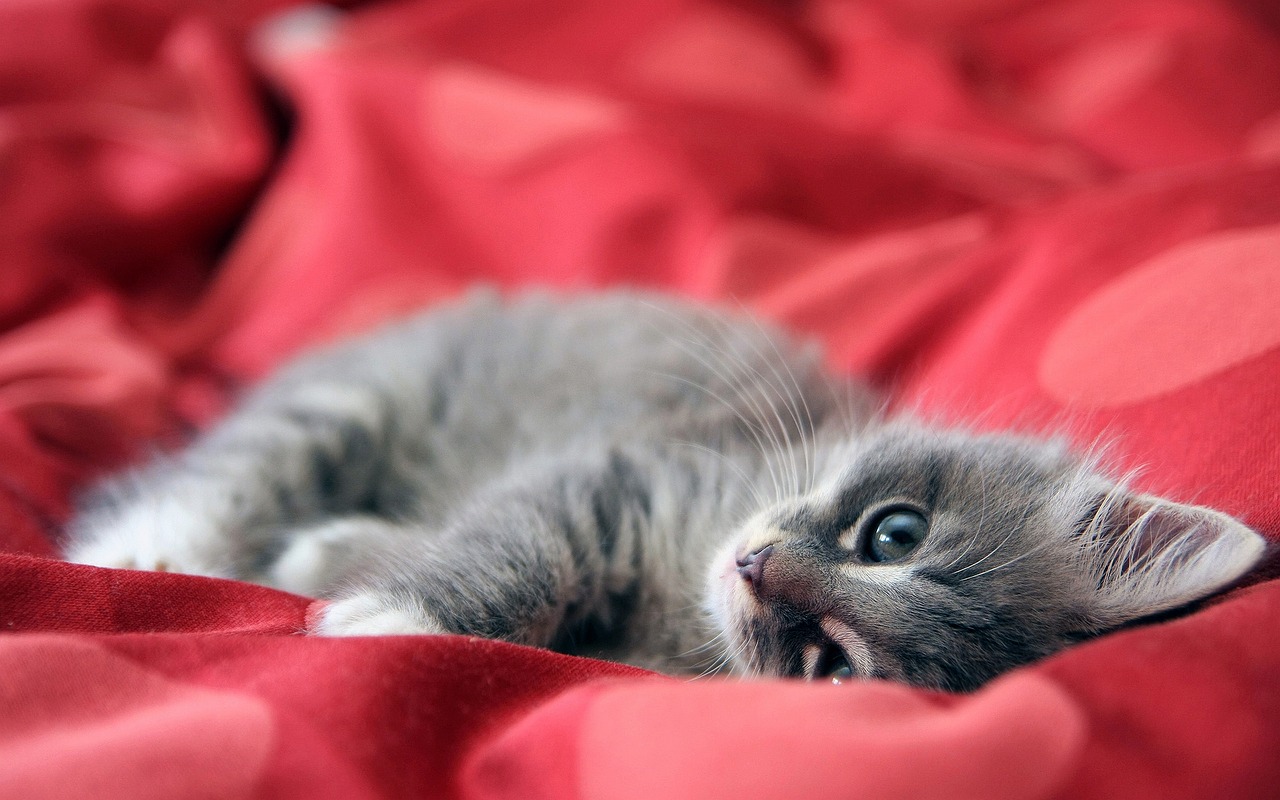
Hydration Tips for Different Travel Types
When it comes to traveling with your furry friends, hydration is not just a luxury—it's a necessity! Different travel scenarios demand unique approaches to keep your pet happily hydrated. Whether you're hitting the open road, flying high in the sky, or camping under the stars, each setting presents its own hydration challenges. Let’s dive into some practical tips to ensure your pet stays refreshed and healthy throughout your journey.
For road trips, the key is to make hydration a regular part of your travel routine. Just like you might stop for a coffee break, plan for water breaks every couple of hours. This not only gives your pet a chance to drink but also allows them to stretch their legs. Bring along a portable water bowl and a cooler filled with fresh water. Remember, pets can get car sick, so offering small amounts of water frequently is better than overwhelming them with a full bowl at once.
When flying with your pet, hydration can become a bit trickier. Most airlines require pets to be in a carrier, and access to water may be limited during the flight. To combat this, consider these tips:
- Pre-flight hydration: Ensure your pet drinks plenty of water before leaving home.
- Use a spill-proof water bottle: Invest in a water bottle designed for pets that can be attached to the carrier for easy access.
- Hydration during layovers: If you have a layover, take your pet out for a bathroom break and offer them water.
Now, if you’re planning a camping adventure, hydration is crucial, especially if you're in hot weather. Always carry ample water—both for you and your pet. If you're hiking, take breaks in the shade and offer your pet water regularly. A collapsible bowl is perfect for these situations as it’s lightweight and easy to pack. Additionally, always scout for natural water sources, but make sure they’re safe for your pet to drink from.
Lastly, always be prepared for unexpected situations. Carry extra water in case of delays or emergencies. It's better to have too much than not enough. By planning ahead and adapting your hydration strategy to your travel type, you can ensure that your pet remains comfortable and hydrated, ready to enjoy every moment of the adventure!
Q: How much water should I give my pet while traveling?
A: The amount of water varies based on your pet's size and activity level, but a good rule of thumb is about one ounce of water per pound of body weight per day. Adjust this based on your travel conditions, especially in hot weather.
Q: Can I give my pet ice cubes instead of water?
A: While ice cubes can be a fun treat, they should not replace water. Offer ice cubes as a supplement to help cool them down, but always provide liquid water for proper hydration.
Q: What if my pet refuses to drink water during travel?
A: If your pet is reluctant to drink, try offering water in different containers or adding a splash of low-sodium chicken broth to entice them. You can also use a syringe (without the needle) to gently squirt small amounts of water into their mouth if necessary.
Q: Are there any signs that my pet is dehydrated?
A: Yes! Look out for dry gums, lethargy, and loss of skin elasticity. If you notice these signs, offer water immediately and consult a veterinarian if symptoms persist.
Frequently Asked Questions
- Why is hydration important for pets while traveling?
Keeping your pets hydrated during travel is crucial for their overall health and well-being. Just like humans, pets can suffer from dehydration, especially when they are in unfamiliar environments or during long journeys. Dehydration can lead to serious health issues, so ensuring they have access to fresh water is essential.
- How much water do pets need while traveling?
The amount of water your pet needs can vary based on their size, age, and activity level. Generally, dogs require about one ounce of water per pound of body weight daily, while cats need about half that amount. It's important to monitor their intake and provide water regularly, especially during stops or breaks.
- What types of water containers are best for traveling with pets?
When traveling with pets, consider using portable water bowls or insulated water bottles. Portable bowls are lightweight and easy to pack, while insulated bottles keep water cool for longer. Collapsible bowls are also a great space-saving option that allows you to provide water without taking up too much room in your travel gear.
- How can I tell if my pet is dehydrated?
Look for physical signs such as dry gums, lethargy, and skin that doesn’t bounce back when pinched. Behavioral changes like excessive panting or reluctance to move can also indicate dehydration. Recognizing these signs early can help you take action to rehydrate your pet promptly.
- What hydration strategies should I use for different types of travel?
For road trips, schedule regular water breaks every couple of hours. If flying, check with the airline about their policies on pet hydration. For camping, always have a portable water source available and keep your pet cool in the shade. Tailoring your approach based on the travel type can make a significant difference in keeping your pet hydrated.

